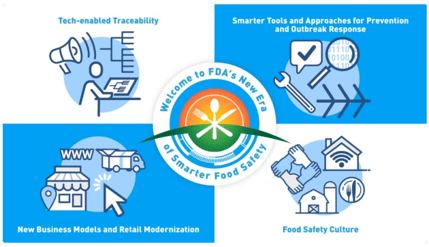The New Era of Smarter Food Safety represents a new approach to food safety, leveraging technology and other tools to create a safer and more digital, traceable food system.
-New Era for Food Safety: Blueprint for the Future, FDA, 2021
The Food Safety Modernization Act is not new. Congress passed the law in 2011 to give the FDA the ability to initiate mandatory recalls and a host of other powers over the food industry. In 2020 the FDA issued a major proposed update to the rules: “The New Era of Smarter Food Safety.” Although the final rules will not be published until 2022, the outlines are clear.

The rule builds on four core elements: Tech-Enabled Traceability, Smarter Tools, Food Safety Culture, and New Business Models. Lots of words and implications. You can read more on the FDA website, but here is our take on what this means for the seafood industry.
The key update is Section 204 designed in the words of the FDA to “harmonize the Key Data Elements and Critical Tracking Events for enhanced traceability.” The goal is to have end-to-end traceability that can enable tracebacks in seconds--instead of the current system that often fails and generally takes weeks. Here are some of the implications for seafood companies:
- Seafood gets special attention: The FDA ran risk-models on what foods lead to the biggest food safety issues, all seafood (except scallop adductor muscles and catfish) ended up on the list along with leafy greens, eggs and numerous other products.
- New Acronyms (KDE and CTE) get added to HACCP: For most distributors, the system will build on their existing HACCP program by mandating the tracking of Key Data Elements (KDEs) through Critical Tracking Events (CTEs).
- Digital is Required: The mandate is for nearly every participant to provide a sortable spreadsheet to the FDA within 24 hours of request--essentially meaning that most companies must have a digital record.
- Lot Codes are Key: Harvesters are required to put a unique identifier (lot code) on each harvest and that information should travel with the product through the supply chain.
- The First Mile will be the hardest: Harvester/Growers are expected to collect and pass key information (including a lot code) about every harvest to the first buyer.
- Interaction with other regulations is unknown: Most notably the shellfish regulations which already require very similar information and tracking (minus the digital pieces).
As the diagram below describes, the expectation is that Key Data Elements are passed from one step to the next--so there can be a rapid traceback if there is a problem.
Although the goal of safer food is a good one and the specific rules are under final revision, the impact on the seafood industry could be far reaching. Here are some of the biggest challenges we see for adoption:
- Small non-technical suppliers:
- Fisherman/growers are great at a lot of things. Technology is generally not one of those things. From that oyster farmer in a Carolina skiff to the lobsterman or the long liner, most harvesters are not using a lot of technology.
- Fisherman/growers are great at a lot of things. Technology is generally not one of those things. From that oyster farmer in a Carolina skiff to the lobsterman or the long liner, most harvesters are not using a lot of technology.
- Long Supply Chains:
- Five plus stops in a chain is not unusual. Passing information between all those players seamlessly is a big task. This requires new protocols and standards.
- Five plus stops in a chain is not unusual. Passing information between all those players seamlessly is a big task. This requires new protocols and standards.
- Fast turn around:
- No one wants rotting fish. Inventory churn is measured in minutes/hours, not days and weeks.
- No one wants rotting fish. Inventory churn is measured in minutes/hours, not days and weeks.
- Employees turnover is a real problem and there are often language problems
- There is little appetite for hiring tech folks or spending large amounts training new employees.
- There is little appetite for hiring tech folks or spending large amounts training new employees.
- Data Sharing:
- Most companies do not want to share who they buy from and who they sell to with others in the chain. Traceability challenges that business practice.
Anyone who has spent time on a fishing vessel or seafood processing plant, knows that most companies still use a lot of paper and don’t have the systems needed to meet the FDA’s vision of, “food traced to its source in seconds.” Not to mention, “alerting consumers in real time before contaminated or misbranded foods are consumed.”
There is a lot more to come about this rule, but now is a good time to start thinking about your digital strategy. How do you collect, store and transfer key information about your product?
There are solutions out there (including BlueTrace) and you should look at a few.


